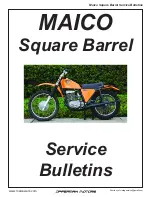
30
ENGLISH
In order to maintain a good maneuverability of the vehicle, the steering mechanism should be
maintained on a regular basis. For the first 1500km and every 600km afterwards a motorcycle runs,
the steering mechanism should be demolished to check the bearing rings and balls for any abrasion. If
necessary, install new pieces. Balls must be replaced completely. The mixed use of old and new balls is
not permitted.
The maintenance of steering column focuses on the thrust bearing. If the bearing is not lubricated for
a long time and adjusting nuts become loose, it will result in excessively lengthened bearing clearance
and the vehicle may jitter dramatically in the driving, affecting the stability and safety of the vehicle. On
the other hand, if the bearing is damaged or adjusting nuts are screwed too tight, the steering bar may be
subject to undue rotation resistance or even be stuck, resulting in operational difficulties and even out-of-
control.
Hold up the vehicle with a main stand-up and make the front wheel hang in the air. Shake the front
fork or front damper, and check the bearing for any looseness. Steer to the left and right to check whether
the bearing is flexible. Whether too tight or too loose, it should be adjusted. Loosen the lock nuts on the
steering column. While turning the adjusting nuts, check the bearing for its degree of tightness until it
becomes normal, and then re-tighten the lock nuts on the steering column.
The motorcycle is steered by manipulating the steering bar. The steering bar is connected with the
steering column. As the frame stand pipe is centered, the twirl of the steering column drives the front
damper so as to steer the front wheel.
Section 7 Steering Gear
1. Structure and Working Principles of Steering Mechanism
2. Demolition and Maintenance of Steering System
[1]Steering bar
On the right of the steering bar is the throttle twist grip, which controls the fuel flow, the right handle
is the front brake handle. The RHS and LHS bars have been installed with the left and right combination
switches, rearview mirrors, air choke switch and so on.
[2]Steering column
The steering column is an important part of the motorcycle steering mechanism, including the steering
column, lower yoke plate, bearing, bearing rings and other components. The steering column and the lower
yoke plate are jointed together and set in the frame stand pipe. The mass of the motorcycle and the crew is
transmitted to the front wheel via the steering column, while the impact load generated by the impact from
the road surface is transmitted to the motorcycle body through the steering column. Therefore, the steering
column has to bear a greater impact load, and also to ensure the flexible rotation in the running.
Refer to Table 4-6 in respect of damage forms, fault phenomena and common maintenance
methods of the steering column:
Table 4-6: Maintenance of the Steering Column
Component
Name
Damage Form
Component Fault
Phenomenon
Motorcycle Fault
Phenomenon
Maintenance Method
Ball race
A d j u s t i n g n u t s a r e
screwed too tight.
There leave a too narrow
fit clearance between balls
and ball races.
The steering bar cannot be
turned flexibly.
A d j u s t n u t s w i t h a
wrench until the steering
column can be twisted
flexibly and there is no
axial movement between
the steering column and
the stand pipe.
The ball raceways are
excessively braded, or
have pits, dents, cracks
and damage.
-----------------
The steering bar cannot be
turned flexibly, and jitters
or shakes in the driving.
Replace a complete set
of ball races.
Ball
B a l l s a r e a b r a d e d,
deformed or damaged.
-----------------
The steering bar cannot be
turned flexibly, and jitters
or shakes in the driving.
Replace a complete set
of balls.
S t e e r i n g
column
The steering column is
bent and deformed.
The steering column is
bent and deformed.
The motorcycle runs off
tracking and the steering
bar does not work.
Rectify or replace the
steering column.
















































